
There are few sounds more distinctive than that of a woodpecker drumming away on a tree. Often considered to be lucky, they are known in many places as a symbol of friendship and happiness. With around two hundred species, woodpeckers are found across many countries and they play an important role in other wildlife, creating holes that many other birds then nest in, such as owls, starlings, sparrows, and many more. The smallest woodpecker is the downy woodpecker at only a few inches long, but many far exceed that. Here we have ranked the largest woodpeckers in the world by length.
#10 Largest Woodpecker: Levaillant’s Woodpecker
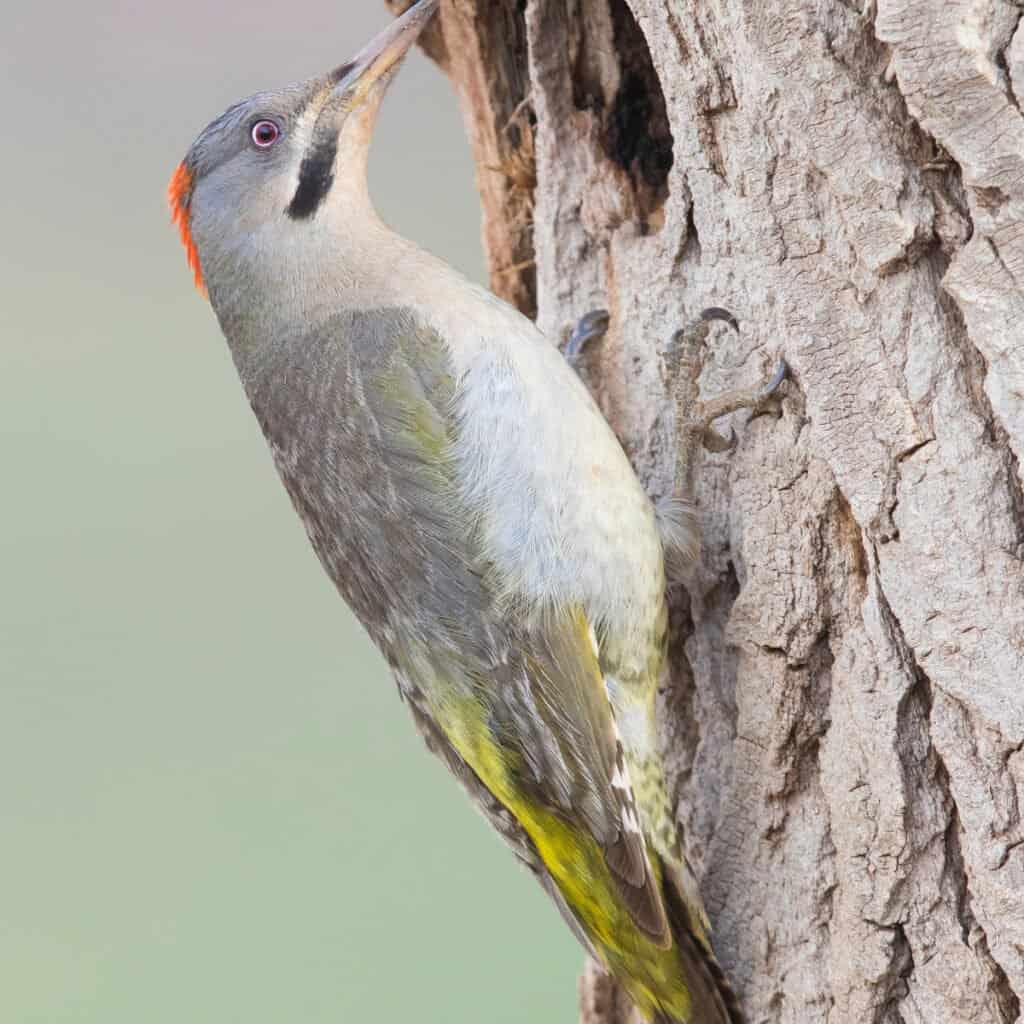
The Levaillant’s woodpecker can be found in North
Africa
©Agami Photo Agency/Shutterstock.com
The Levailant’s woodpecker is found in the mountainous forests of Algeria, Morocco, and Tunisia and was named after the French explorer, François Le Vaillant. They can reach lengths of around 13 inches and have a wingspan of 20 inches. Levaillants’ woodpeckers are dark green with a lighter green belly and breast and males have a patch of red on the top of their heads while females have a grey patch. They are often described as being similar to the larger European Green woodpecker, both in appearance and vocally. Levaillant’s woodpeckers make a hole in a tree to nest in where they make a bed of wood chips for their eggs to be laid on. They usually lay between 4 and 8 eggs during the breeding season which is from March to June.
#9 Largest Woodpecker: Northern Flicker
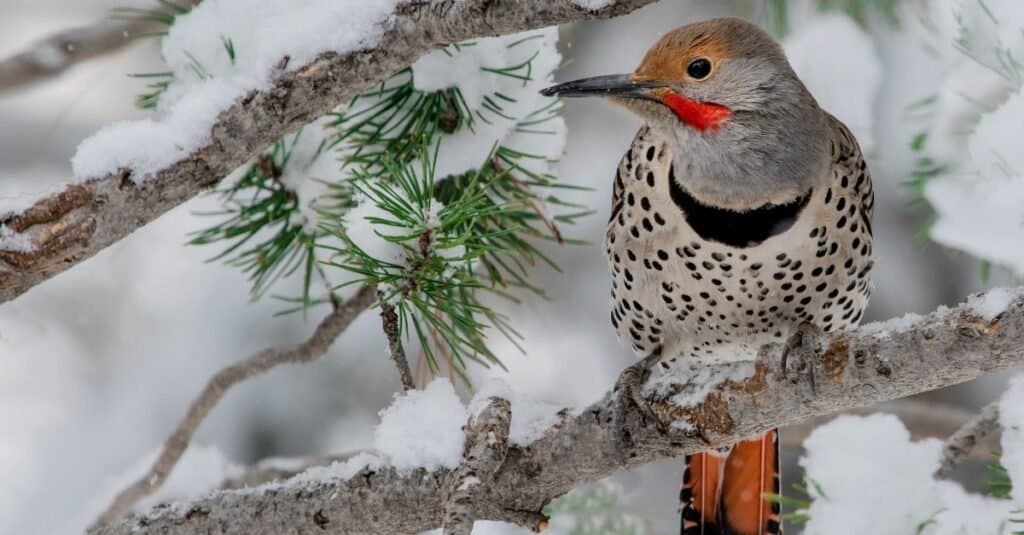
Northern flicker woodpeckers can measure up to 14 inches
©iStock.com/DawnKey
The northern flicker, also known as the common flicker and the yellowhammer, can reach lengths of up to 14 inches. They are native to North America and Central America but are also found in Cuba and the Cayman Islands. There are two types of northern flicker – yellow-shafted and red-shafted. All of the northern flickers are usually a pale brown color with black spots on their bodies and grey heads but the yellow-shafted males have a patch of red on the back of their heads while the red-shafted males have it on the side of their face instead.
Northern flickers mate for life and the males usually do most of the work of creating a nest for the female to lay her eggs in. They are also one of the more unusual woodpeckers as they migrate – traveling further south for the winter – and the males are extremely territorial, often pecking on metal objects as well as trees to make a louder sound.
#8 Largest Woodpecker: Lineated Woodpecker
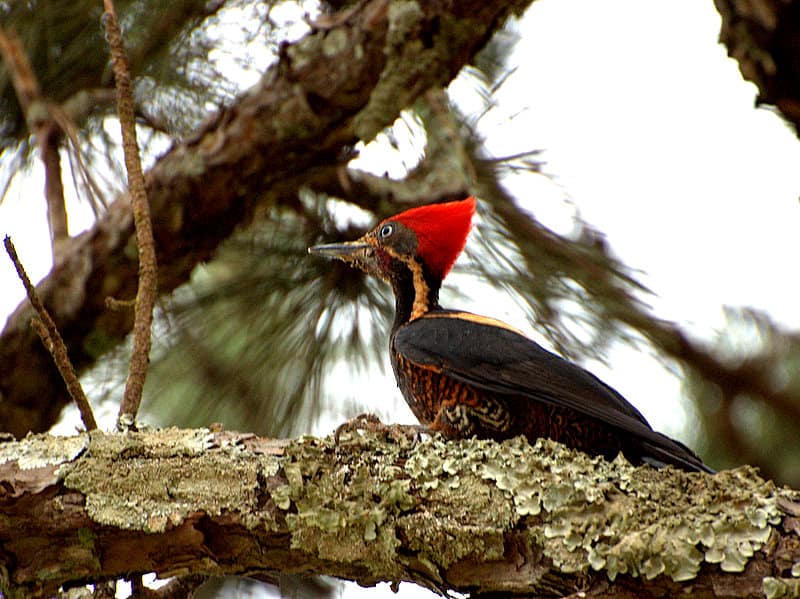
Lineated woodpeckers are found mainly across Argentina, Mexico, and Trinidad where they prefer lowland forests and woodland areas.
©Dario Sanches, CC BY-SA 2.0 – License
Lineated woodpeckers are slightly larger than northern flickers, reaching lengths of around 14.2 inches, and are found mainly across Argentina, Mexico, and Trinidad where they prefer lowland forests and woodland areas. With a bright red, tufted crest they have a stunning appearance, albeit they are known to be similar to the pileated woodpecker. The rest of their head, wings, and back are black, although they have white stripes down their neck and back while their breast is a combination of black and fawn stripes. They peck holes in trees in search of ants and beetles, although they also eat fruit and nuts. Lineated woodpeckers make their nests in dead trees and the male and female both share the duties of hatching the eggs.
#7 Largest Woodpecker: European Green
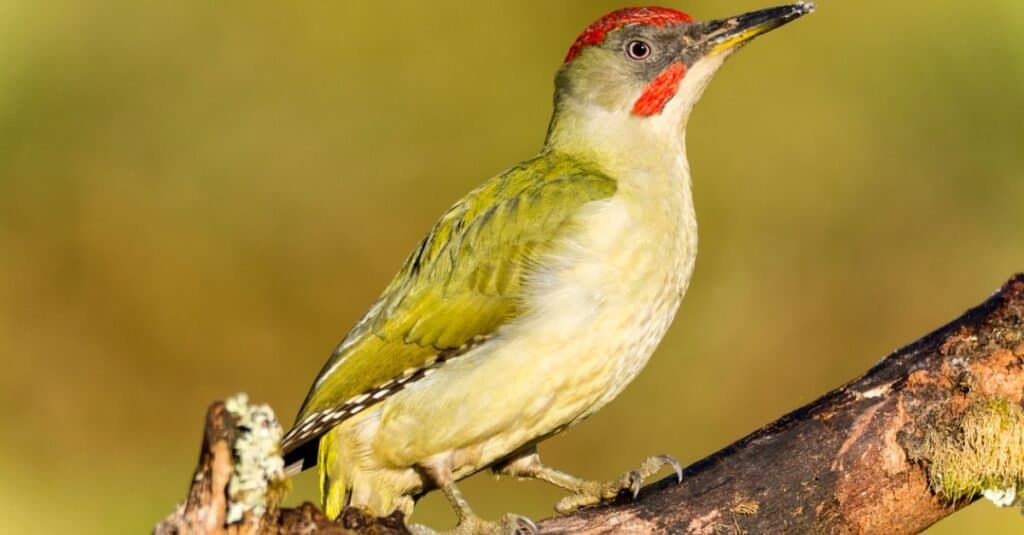
The European green woodpecker can grow up to 14 inches long
©Studioimagen73/Shutterstock.com
Also reaching a length of 14.2 inches is the European green woodpecker which is widespread across Europe. They have a similar appearance to the Levaillant’s woodpecker with green wings and back and a paler belly and a red patch on their head. European greens prefer an open habitat and are often found around small woodland areas, hedges, and scattered trees. They are notable for being extremely shy woodpeckers, and they have rarely heard drumming, although they do have a loud call. European greens mainly feed on ants which they forage on the floor for – something that can cause them problems during snowy weather as the ant nests are often covered, which can lead to food shortages.
#6 Largest Woodpecker: Magellanic Woodpecker
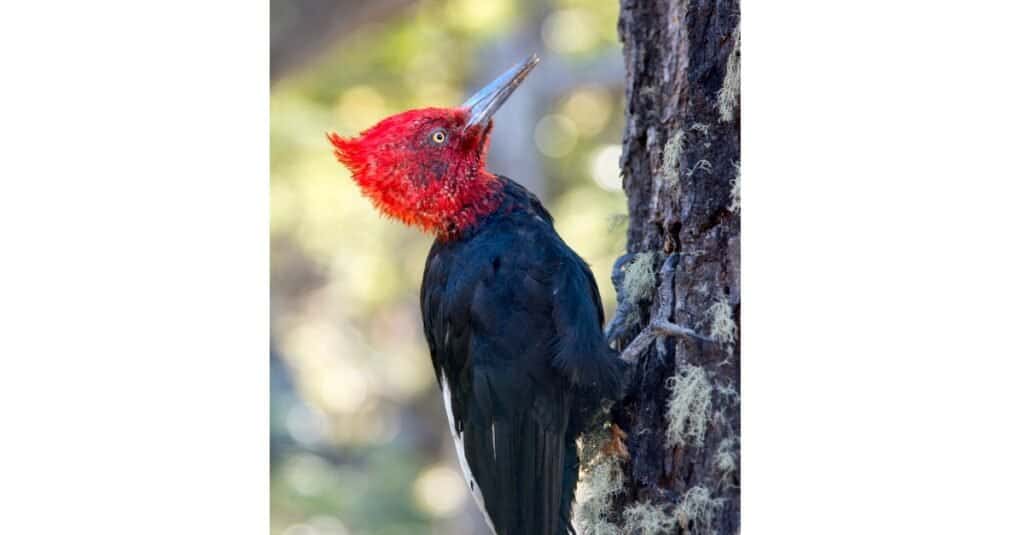
Magellanic woodpeckers are found in South America
©iStock.com/nikpal
The Magellanic woodpecker is found in woodland areas of Argentina and Chile and, at lengths of around 18 inches, it is known as being the biggest woodpecker in South America. These woodpeckers are almost entirely black, with the exception of a white patch on their wings and a red crest on the male’s head. Magellanic woodpeckers eat a range of insects, including spiders and beetles, and also small reptiles and bats. These woodpeckers usually live in family groups of parents and offspring from previous years and are extremely aggressive and territorial when nesting. They lay two eggs and both parents share the duties of incubating them but one chick usually dies before they are old enough to leave the nest.
#5 Largest Woodpecker: Pileated Woodpecker
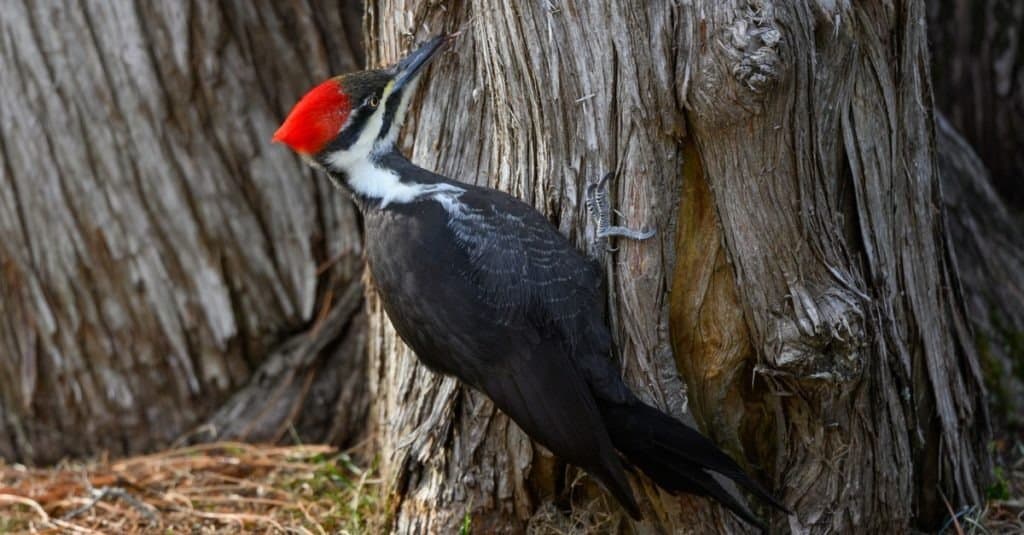
A pileated woodpecker pecking at a tree
©FotoRequest/Shutterstock.com
Pileated woodpeckers are native to North America and Canada where they prefer to live in thick deciduous forests. They reach lengths of around 19 inches and get their name from the Latin word for “capped” which is pileatus and is a reference to their vibrant red crest. As well as a red crest, they have black bodies with white markings on their face and throats. Pileated woodpeckers have a varied diet and eat carpenter ants, beetles, fruit, nuts, and berries. Rather than a traditional round hole, these woodpeckers often make holes that are rectangular when they are searching for insects in the trees. During the breeding season, the male makes a nest first in order to attract a female to mate with.
#4 Largest Woodpecker: Ivory-Billed Woodpecker

Illustration of Ivory-Billed Woodpecker.
©Leo’s Book Club/Shutterstock.com
There is perhaps no other woodpecker whose very existence has been so precarious over the years than the ivory-billed woodpecker. Reaching lengths of around 21 inches and found only in the Southern United States and Cuba, the ivory-billed woodpecker was originally classed as endangered as early as the 1880s and has been thought to be extinct many times, but each time they prove the experts wrong and another small population of them is found. They prefer a forest habitat that has come under threat due to logging and sadly, they are now officially classed as near extinction to date it is not known whether any more exist or if they have finally lost the battle to survive. Ivory-billed woodpeckers are mostly black with white markings down their neck and a small white patch on their wings. Males have a red crest while females are black and they mate for life.
#3 Largest Woodpecker: Black Woodpecker
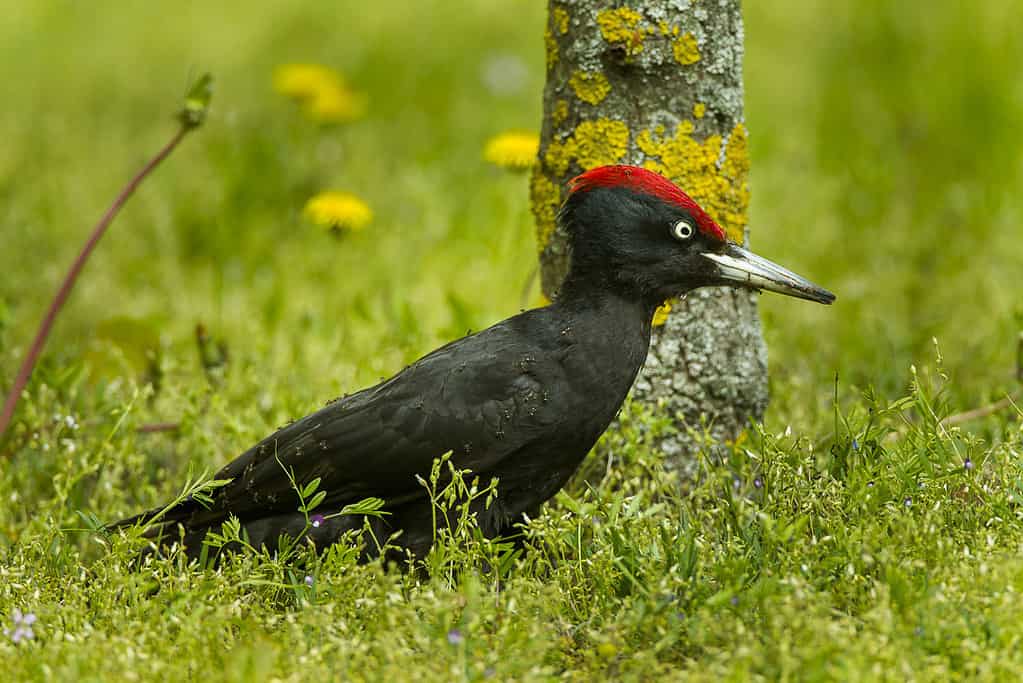
The black woodpecker is native to the majority of Europe but not the United Kingdom.
©Francesco Veronesi from Italy, CC BY-SA 2.0 – License
The black woodpecker is only slightly larger than the ivory-billed woodpecker, with a length of 22 inches, but is in a much more secure position as their numbers are healthy. Black woodpeckers are found in forest regions across parts of Asia – including China, Korea, and Japan – and they are also native to the majority of Europe, although not the UK. As their name suggests, they are black, although males have a redhead, while only the upper part is red on females. Pine martens are notable predators of black woodpeckers as they feed on the eggs, and often even kill the females while they are sitting in the nest.
#2 Largest Woodpecker: Great Slaty Woodpecker
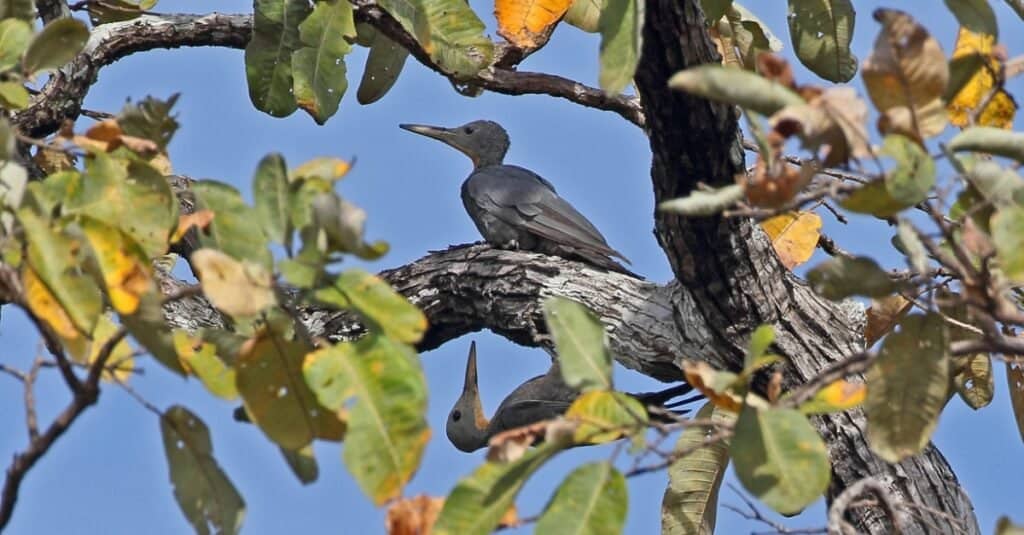
©iStock.com/neil bowman
The great slaty woodpecker is found in forest regions in parts of Asia, including Bangladesh, India, Indonesia, Malaysia, the Philippines, Thailand, and Vietnam. With the current largest woodpecker – the Imperial – under serious threat, the great slaty stands a good chance of taking over the number one spot in the near future with a length of 23 inches, although even these are classed as being vulnerable. Great slaty woodpeckers have unusually thin necks which make them easy to identify, along with their grey coloring and red markings around their throat. Although they are extremely territorial, these woodpeckers only have a quiet call and instead, rely on swinging their heads backward and forwards to ward off others.
#1 Largest Woodpecker: Imperial
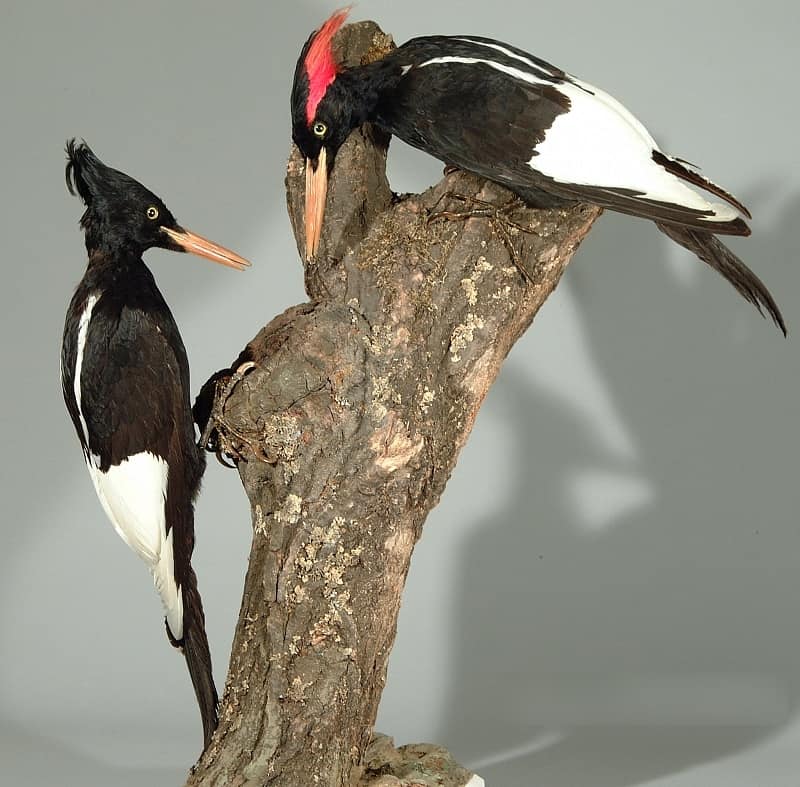
Imperial woodpeckers (on the left) have not been spotted in the wild since 1956, leaving them most likely extinct
©Fritz Geller-Grimm, CC BY-SA 2.5 – License
The largest woodpecker in the world is the Imperial woodpecker. Reaching lengths of 23.6 inches and with a wingspan of 30 inches, they certainly cut an impressive sight. Endemic to Mexico where they prefer the forest regions, these large birds are classed as being critically endangered and are close to extinction. The last sighting of an Imperial was in 1956.
They have black bodies and large white markings on the back of their wings. Like several of the other species, the males have a red crest while the females have a black one. Imperial woodpeckers feed mainly on insect larvae which they usually find underneath the bark of dead trees. One of the reasons that they are so close to extinction is that each breeding pair requires a large area of forest to survive – usually around 10 square miles.
Summary of the 10 Largest Woodpeckers in the World
| Rank | Woodpecker | Size in Inches |
|---|---|---|
| 1 | Imperial Woodpecker | 23.6 |
| 2 | Great Slaty Woodpecker | 23 |
| 3 | Black Woodpecker | 22 |
| 4 | Ivory-Billed Woodpecker | 21 |
| 5 | Pileated Woodpecker | 19 |
| 6 | Magellanic Woodpecker | 18 |
| 7 | European Green Woodpecker | 14.2 |
| 8 | Lineated Woodpecker | 14.2 |
| 9 | Northern Flicker | 14 |
| 10 | Levaillant’s Woodpecker | 13 |
The photo featured at the top of this post is © FotoRequest/Shutterstock.com
Thank you for reading! Have some feedback for us? Contact the AZ Animals editorial team.






